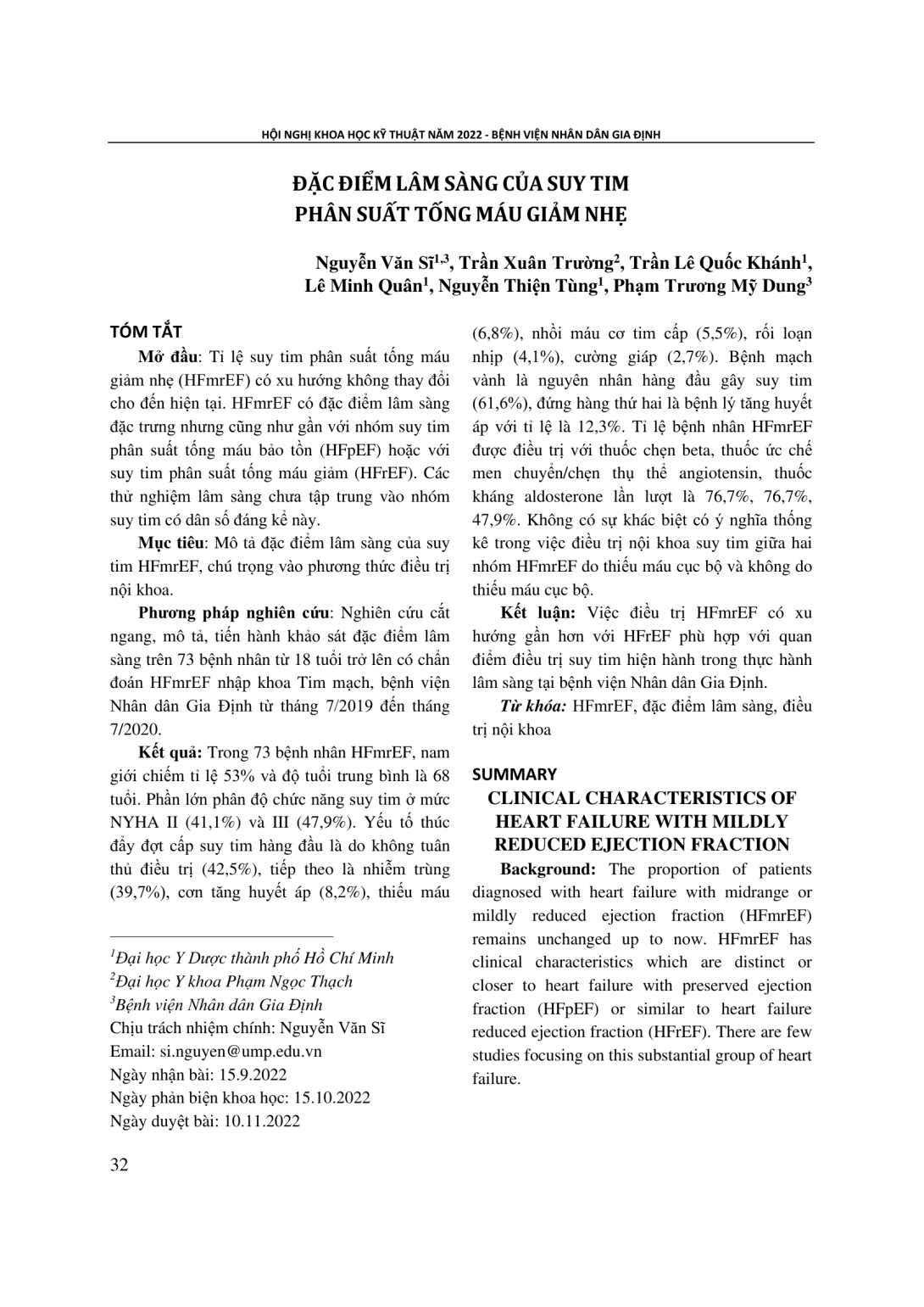
Mô tả đặc điểm lâm sàng của suy tim HFmrEF, chú trọng vào phương thức điều trị nội khoa. Phương pháp nghiên cứu: Nghiên cứu cắt ngang, mô tả, tiến hành khảo sát đặc điểm lâm sàng trên 73 bệnh nhân từ 18 tuổi trở lên có chẩn đoán HFmrEF nhập khoa Tim mạch, bệnh viện Nhân dân Gia Định từ tháng 7/2019 đến tháng 7/2020. Kết quả: Trong 73 bệnh nhân HFmrEF, nam giới chiếm tỉ lệ 53% và độ tuổi trung bình là 68 tuổi. Phần lớn phân độ chức năng suy tim ở mức NYHA II (41,1%) và III (47,9%). Yếu tố thúc đẩy đợt cấp suy tim hàng đầu là do không tuân thủ điều trị (42,5%), tiếp theo là nhiễm trùng (39,7%), cơn tăng huyết áp (8,2%), thiếu máu (6,8%), nhồi máu cơ tim cấp (5,5%), rối loạn nhịp (4,1%), cường giáp (2,7%). Bệnh mạch vành là nguyên nhân hàng đầu gây suy tim (61,6%), đứng hàng thứ hai là bệnh lý tăng huyết áp với tỉ lệ là 12,3%. Tỉ lệ bệnh nhân HFmrEF được điều trị với thuốc chẹn beta, thuốc ức chế men chuyển/chẹn thụ thể angiotensin, thuốc kháng aldosterone lần lượt là 76,7%, 76,7%, 47,9%. Không có sự khác biệt có ý nghĩa thống kê trong việc điều trị nội khoa suy tim giữa hai nhóm HFmrEF do thiếu máu cục bộ và không do thiếu máu cục bộ. Kết luận: Việc điều trị HFmrEF có xu hướng gần hơn với HFrEF phù hợp với quan điểm điều trị suy tim hiện hành trong thực hành lâm sàng tại bệnh viện Nhân dân Gia Định.
The proportion of patients diagnosed with heart failure with midrange or mildly reduced ejection fraction (HFmrEF) remains unchanged up to now. HFmrEF has clinical characteristics which are distinct or closer to heart failure with preserved ejection fraction (HFpEF) or similar to heart failure reduced ejection fraction (HFrEF). There are few studies focusing on this substantial group of heart failure. Objective: To describe the clinical characteristics of HFmrEF, focusing on medical treatment. Methods: A descriptive cross-sectional study surveying clinical characteristics of 73 patients older than 18 years with HFmrEF diagnosis admitted to Cardiology Department of Nhan dan Gia Dinh Hospital from July 2019 to July 2020. Results: Among 73 patients with HFmrEF diagnosis, there are 53% male with the mean age of 68 years. The most common precipitating factors of heart failure exacerbation were nonadherence (42.5%), followed up by infection (39.7%), hypertensive crisis (8.2%), anemia (6.8%), acute myocardial infarction (5.5%), arrhythmia (4.1%) and hyperthyroidism (2.7%). Ischemic heart disease was the most leading cause of HFmrEF (61.6%), followed by hypertension with the rate of 12.3%. The rates of HFmrEF patients treated with beta-blocker, ACE inhibitors/angiotensin II receptor antagonists and aldosterone receptor antagonists were 76.1%, 76.71% and 47.9%, respectively. There was no difference in the treatment of the aforementioned medications between HFmrEF due to ischemic and non-ischemic causes. Conclusion: The treatment practice of HFmrEF at Nhan dan Gia Dinh Hospital was close to HFrEF which is compatible with current therapeutic perspective.
- Đăng nhập để gửi ý kiến
